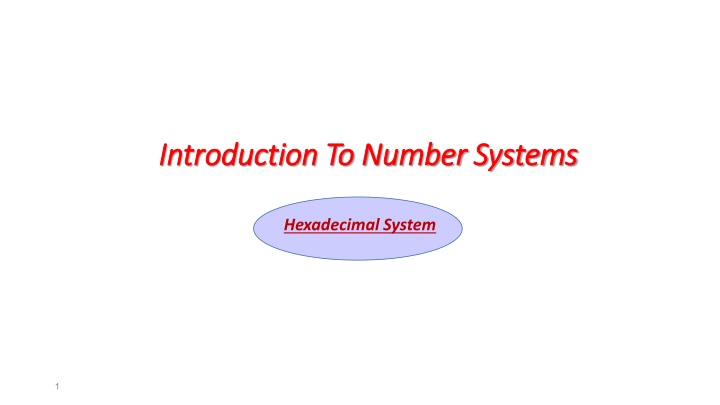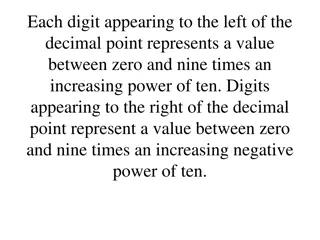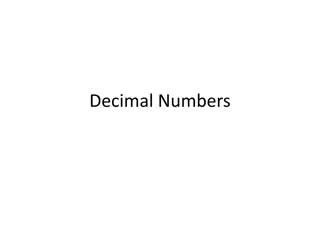
Exploring Hexadecimal Number System and Conversions
Discover the Hexadecimal System, its unique base-16 structure, and how to convert between hexadecimal and decimal, binary, or vice versa. Learn the principles and methods for these conversions in an easy-to-follow format with examples included.
Download Presentation

Please find below an Image/Link to download the presentation.
The content on the website is provided AS IS for your information and personal use only. It may not be sold, licensed, or shared on other websites without obtaining consent from the author. If you encounter any issues during the download, it is possible that the publisher has removed the file from their server.
You are allowed to download the files provided on this website for personal or commercial use, subject to the condition that they are used lawfully. All files are the property of their respective owners.
The content on the website is provided AS IS for your information and personal use only. It may not be sold, licensed, or shared on other websites without obtaining consent from the author.
E N D
Presentation Transcript
Introduction To Number Systems Introduction To Number Systems Hexadecimal System 1
Hexadecimal System Hexadecimal System Hexadecimal is the name given to a special number system which uses "16" as a base. In a hexadecimal (base 16) system, we need 16 single digits. We could use 0-9, then invent six more. More conveniently, we use the letters A - F for the remaining digits (where A = 10, B = 11, C = 12, D = 13, E = 14 and F = 15). 2
Hexadecimal to Decimal Conversion Hexadecimal to Decimal Conversion The principle of converting a base 16 number to decimal is the same as previously discussed, except that each column now represents an increasing power of 16 . Example 1 Convert D30C16 to decimal. Solution D30C16 = 13x163+ 3x162+ 0x161+ 12x160 = 13x4096 + 3x256 +0 + 12 =53248 + 768 + 12 = 54028 3
Decimal To Hexadecimal Conversion Decimal To Hexadecimal Conversion Similarly, any decimal number can be converted to hexadecimal by successive divisions by 16, keeping track of the remainder. Example 2 Convert 2,56310to base 16, Solution 4
Binary To Hexadecimal Conversion Binary To Hexadecimal Conversion Hexadecimal has another important property. Since there are exactly 16 hexadecimal digits, it requires exactly 4 bits to represent every hexadecimal digit (since 24= 16). In order to convert the Binary number into its equivalent octal numbers, split the given binary number into groups and each group should contain four binary bits (because 24=16), add zeros to the left if necessary, and then converting each group into its equivalent octal number. This can be shown by the following table on the right: 5
Binary To Hexadecimal Conversion Binary To Hexadecimal Conversion Example 3: Convert (100000111001110)2to hexadecimal. Solution: 6
Hexadecimal To Binary Conversion Hexadecimal To Binary Conversion To convert Hexadecimal to binary, replace each Hexadecimal digit by its binary representation in 3 bits, so add zeros to the left if necessary. Example 4: Convert F2D316to binary. Solution: 7
Octal to Hexadecimal Conversion Octal to Hexadecimal Conversion When converting from octal to hexadecimal, it is often easier to first convert the octal number into binary and then from binary into hexadecimal. Example 5 Convert 345 octal into hex. Solution: 8
Hexadecimal To Octal Conversion Hexadecimal To Octal Conversion When converting from hexadecimal to octal, it is often easier to first convert the hexadecimal number into binary and then from binary into octal. 9
Example 6 Convert A2DE hex into octal: Solution: 10
Hexadecimal Addition: Hexadecimal Addition: Use the following steps to perform hexadecimal addition: 1. Add one column at a time. 2. Convert to decimal and add the numbers. 3a. If the result of step two is 16 or larger subtract the result from 16 and carry 1 to the next column. 3b. If the result of step two is less than 16, convert the number to hexadecimal. 11
Example 7: Add: AC5A9+ED694 Solution: 12
Hexadecimal Subtraction Hexadecimal Subtraction Subtraction in hexadecimal works similar to subtraction in decimal except that we occasionally have a digit larger than 9. 14
Example: Subtract A8D2 - 3EAC (hexadecimal) Solution: 15
Homework Homework All Exercises Page 24 18





















